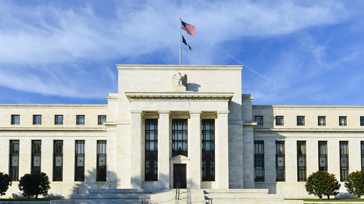Key Highlights
- This Monday US lawmakers failed to agree on raising the US debt limit
- A US government shutdown cannot be ruled out, but default is unlikely
- In the short term, equity markets may be volatile but may not necessarily end lower
Yet again
Over the past 20 years, US lawmakers have used the country's debt ceiling as a political tool. In this dangerous game of brinkmanship, both the Democrats and Republicans have shown their willingness to step ever closer to the edge of the precipice.
On Monday, Republicans in Congress voted to reject a Democrat-proposed bill aimed at averting a government shutdown on October 1. Without suspending or raising the current statutory debt limit of $28.5 trillion, the government is expected to run out of cash sometime over the next two months.
Yet markets feel they have seen it all before. Warnings have come from Treasury Secretary Janet Yellen of possible "catastrophic" economic impact, and from John Williams, President of the Federal Reserve Bank of New York of potentially "very negative" market dynamic. But these have so far not elicited a strong market reaction.
What can happen next?
The Democrats still have some legislative options to overcome the blocking of a vote to extend the debt limit. The legislative process is complicated but ultimately we think it is likely that the debt limit will be raised in the coming month. However, if this does not materialise, then the government will likely continue to meet its debt obligations while searching for ways to save cash. This includes the possibility of a government services shutdown or a sharp cut in federal spending.
Shutdowns are of course not new to the US. Since 1980, there have been 14 government shutdowns and some of these have been fairly lengthy. In 2013, for example, during the Obama presidency, the shutdown lasted 16 days. In 2018 under President Trump, this extended to 35 days, the longest in US history.
For most of these lockdowns, the pattern of resolution has been somewhat standard. Political and social pressure builds over time, forcing politicians to bring the shutdown to an end and to extend the debt ceiling. However, during the shutdown period, there is a loss of consumer and business confidence that takes a toll on the economy.
Bond market impact
At this point, it appears that most investors are more focused on the timing of the US's tightening and rate hike measures than the debt ceiling crisis. The market mood is that resolution of this crisis will happen, as with others in the past.
However, if the current impasse drags on, bond markets can be expected to become more nervous. While a full scale or protracted bond default seems highly unlikely, even the prospect of minor payment delays can be highly disruptive to bond markets.
In the run-up to the projected date that the debt ceiling will be reached, those Treasury notes expected to mature close to this date can be expected to see higher yields. According to Federal Reserve economists' estimates, this ranged from 21 to 46 basis points in the 2013 debt ceiling impasse. The same study noted that yields across all maturities also rose, but only marginally by between 4 to 8 basis points. This has previously resulted in the inversion of some yield curves, that is, very short term bills seeing higher yield levels than longer term ones.
The bonds most likely to be affected in the current crisis depends on the precise schedule for the debt ceiling to be reached. Here as elsewhere, the Covid pandemic has exacerbated the problem. Covid-relief packages and tax receipts amid Covid lockdowns has made it more difficult to forecast this schedule.
And in the near term, the Fed may shrink the volume of Treasuries available in the market by paying down outstanding bills and issuing fewer new ones. About US$460 billion of outstanding bills have been paid down over the past three weeks. This reduced supply is helping to anchor Treasury yields for now.
Equity market impact
Contrary to expectations, the uncertainty arising from previous US government shutdowns has not always caused equity markets to end lower. Across the past 14 shutdowns, the S&P500 emerged higher than its pre-shutdown level. This however is not to say that the ride is a comfortable one. In the 2019 shutdown, the market saw a 7 percent sell down before eventually recovering its losses, and more.
UOBAM's view is that this debt ceiling crisis may cause increased market volatility in the short term but will not detract from a positive market performance over the longer term. Markets this quarter will likely be driven more by concerns over slowing global growth, central bank tightening measures, the Delta variant and China policies than this debt ceiling.
This publication shall not be copied or disseminated, or relied upon by any person for whatever purpose. The information herein is given on a general basis without obligation and is strictly for information only. This publication is not an offer, solicitation, recommendation or advice to buy or sell any investment product, including any collective investment schemes or shares of companies mentioned within. Although every reasonable care has been taken to ensure the accuracy and objectivity of the information contained in this publication, UOB Asset Management Ltd (“UOBAM”) and its employees shall not be held liable for any error, inaccuracy and/or omission, howsoever caused, or for any decision or action taken based on views expressed or information in this publication. The information contained in this publication, including any data, projections and underlying assumptions are based upon certain assumptions, management forecasts and analysis of information available and reflects prevailing conditions and our views as of the date of this publication, all of which are subject to change at any time without notice. Please note that the graphs, charts, formulae or other devices set out or referred to in this document cannot, in and of itself, be used to determine and will not assist any person in deciding which investment product to buy or sell, or when to buy or sell an investment product. UOBAM does not warrant the accuracy, adequacy, timeliness or completeness of the information herein for any particular purpose, and expressly disclaims liability for any error, inaccuracy or omission. Any opinion, projection and other forward-looking statement regarding future events or performance of, including but not limited to, countries, markets or companies is not necessarily indicative of, and may differ from actual events or results. Nothing in this publication constitutes accounting, legal, regulatory, tax or other advice. The information herein has no regard to the specific objectives, financial situation and particular needs of any specific person. You may wish to seek advice from a professional or an independent financial adviser about the issues discussed herein or before investing in any investment or insurance product. Should you choose not to seek such advice, you should consider carefully whether the investment or insurance product in question is suitable for you.





